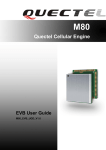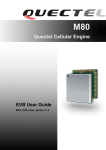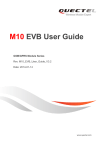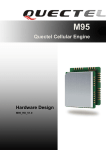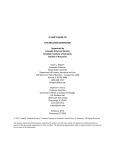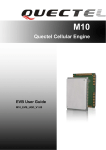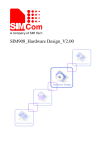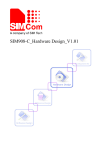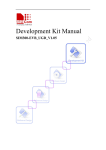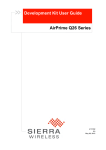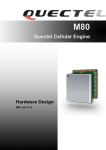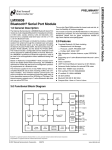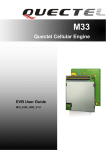Download Sim2 M80 User guide
Transcript
M80 EVB User Guide M80 Quectel Cellular Engine EVB User Guide M80_EVB_UGD_V1.2 M80_EVB_UGD_V1.2 -0- M80 EVB User Guide Document Title M80 EVB User Guide Version 1.2 Date 2012-08-13 Status Released Document Control ID M80_EVB_UGD_V1.2 l e t l c a i e t u n Q fide n o C General Notes Quectel offers this information as a service to its customers, to support application and engineering efforts that use the products designed by Quectel. The information provided is based upon requirements specifically provided for Quectel by the customers. Quectel has not undertaken any independent search for additional relevant information, including any information that may be in the customer’s possession. Furthermore, system validation of this product designed by Quectel within a larger electronic system remains the responsibility of the customer or the customer’s system integrator. All specifications supplied herein are subject to change. Copyright This document contains proprietary technical information which is the property of Quectel Limited. The copying of this document, distribution to others, and communication of the contents thereof, are forbidden without express authority. Offenders are liable to the payment of damages. All rights are reserved in the event of a patent grant or registration of a utility model or design. All specification supplied herein are subject to change without notice at any time. Copyright © Quectel Wireless Solutions Co., Ltd. 2012 M80_EVB_UGD_V1.2 -1- M80 EVB User Guide Contents Contents ............................................................................................................................................ 2 Table Index........................................................................................................................................ 4 Figure Index ...................................................................................................................................... 5 0. Revision history ............................................................................................................................ 6 1. Introduction ................................................................................................................................... 7 1.0. Related documents .............................................................................................................. 7 1.1. Safety precautions ............................................................................................................... 7 2. EVB kit ......................................................................................................................................... 9 2.1. EVB top and bottom view ................................................................................................... 9 2.2. EVB Accessories ............................................................................................................... 10 3. Application.................................................................................................................................. 11 3.1. Power................................................................................................................................. 11 3.1.1. LDO ......................................................................................................................... 11 3.1.2. Test point ................................................................................................................. 12 3.2. Charging ............................................................................................................................ 13 3.3. Audio ................................................................................................................................. 14 3.3.1. Handset .................................................................................................................... 14 3.3.2. Earphone.................................................................................................................. 16 3.3.3. Loud speaker ........................................................................................................... 17 3.3.4. PCM interface.......................................................................................................... 18 3.4. SIM Card ........................................................................................................................... 20 3.5. Antenna ............................................................................................................................. 23 3.6. Communication ................................................................................................................. 24 3.6.1. Main UART............................................................................................................. 24 3.6.2. Auxiliary UART and Debug UART ........................................................................ 26 3.7. SD card .............................................................................................................................. 28 3.8. Switches and buttons ......................................................................................................... 30 3.9. LED indicator .................................................................................................................... 30 3.10. LCD ................................................................................................................................. 31 3.11. Keyboard ......................................................................................................................... 31 3.12. ADC ................................................................................................................................ 32 4. EVB accessories assembly .......................................................................................................... 33 5. Illustration ................................................................................................................................... 34 5.1. Turn on the module ........................................................................................................... 34 5.2. Turn off the module ........................................................................................................... 34 5.3. Emergency off ................................................................................................................... 34 5.4. Communicate with the module.......................................................................................... 34 5.4.1. UART ...................................................................................................................... 34 5.4.2. Auxiliary UART ...................................................................................................... 35 5.5. Firmware upgrade ............................................................................................................. 35 5.6. Charging ............................................................................................................................ 35 l e t l c a i e t u n Q fide n o C M80_EVB_UGD_V1.2 -2- M80 EVB User Guide 5.6.1. Ghost mode.............................................................................................................. 35 5.6.2. Charging mode ........................................................................................................ 36 l e t l c a i e t u n Q fide n o C M80_EVB_UGD_V1.2 -3- M80 EVB User Guide Table Index TABLE 1: RELATED DOCUMENTS ..................................................................................................... 7 TABLE 2: PIN OF ADAPTER INTERFACE ........................................................................................ 11 TABLE 3: PINS OF AIN2/AOUT2 ........................................................................................................ 16 TABLE 4: PINS OF AIN1/AOUT1 ........................................................................................................ 16 TABLE 5: TEST POINTS OF LOUD SPEAKER ................................................................................. 18 TABLE 6: PINS OF PCM CHANNEL .................................................................................................. 19 TABLE 7: PINS OF SIM1 CARD INTERFACE ................................................................................... 21 l e t l c a i e t u n Q fide n o C TABLE 8: PINS OF SIM IC INTERFACE ............................................................................................ 22 TABLE 9: PINS OF SERIAL PORT ...................................................................................................... 25 TABLE 10: PINS OF AUXILIARY UART ............................................................................................ 27 TABLE 11: PINS OF DEBUG UART.................................................................................................... 27 TABLE 12: PINS OF MICRO SD CARD SOCKET ............................................................................. 29 TABLE 13: SWITCHES AND BUTTONS ............................................................................................ 30 TABLE 14: LED INDICATOR .............................................................................................................. 31 M80_EVB_UGD_V1.2 -4- M80 EVB User Guide Figure Index FIGURE 1: EVB TOP VIEW ................................................................................................................... 9 FIGURE 2: EVB BOTTOM VIEW ......................................................................................................... 9 FIGURE 3: ACCESSORIES INTRODUCTION ................................................................................... 10 FIGURE 4: ADAPTER INTERFACE .................................................................................................... 11 FIGURE 5: LDO CIRCUIT ................................................................................................................... 12 FIGURE 6: TEST POINT OF VBAT ..................................................................................................... 12 FIGURE 7: CHARGING CIRCUIT....................................................................................................... 13 l e t l c a i e t u n Q fide n o C FIGURE 8: CHARGING PART ............................................................................................................. 14 FIGURE 9: BLOCK DIAGRAM OF AIN1/AOUT1&AIN2/AOUT2 ................................................... 15 FIGURE 10: PINS OF AIN1/AOUT1&AIN2/AOUT2 .......................................................................... 15 FIGURE 11: CONNECTION BETWEEN HANDSET AND RJ11 ....................................................... 16 FIGURE 12: EARPHONE CIRCUIT .................................................................................................... 17 FIGURE 13: EARPHONE INTERFACE ............................................................................................... 17 FIGURE 14: TEST POINTS OF LOUD SPEAKER ............................................................................. 18 FIGURE 15: BLOCK DIAGRAM OF PCM .......................................................................................... 19 FIGURE 16: PINS OF PCM INTERFACE ............................................................................................ 19 FIGURE 17: TEST POINTS OF PCM INTERFACE ............................................................................ 20 FIGURE 18: CIRCUIT OF SIM1 CARD............................................................................................... 20 FIGURE 19: PINS OF SIM1 CARD CASSETTE ................................................................................. 21 FIGURE 20: PINS OF SIM IC ............................................................................................................... 22 FIGURE 21: ANTENNA CIRCUIT ....................................................................................................... 23 FIGURE 22: ANTENNA INTERFACE ................................................................................................. 23 FIGURE 23: LEVEL MATCH CIRCUIT .............................................................................................. 24 FIGURE 24: PINS OF MAIN UART ..................................................................................................... 25 FIGURE 25: TEST POINTS OF MAIN PORT ...................................................................................... 26 FIGURE 26: AUXILIARY UART PORT AND DEBUG PORT ............................................................ 26 FIGURE 27: TEST POINTS OF AUXILIARY AND DEBUG PORT ................................................... 27 FIGURE 28: MICRO SD CARD CIRCUIT .......................................................................................... 28 FIGURE 29: PINS OF MICRO SD SOCKET ....................................................................................... 28 FIGURE 30: TEST POINTS OF SD CARD .......................................................................................... 29 FIGURE 31: SWITCHES AND BUTTONS .......................................................................................... 30 FIGURE 32: LED INDICATOR ............................................................................................................ 30 FIGURE 33: TEST POINTS OF LCD ................................................................................................... 31 FIGURE 34: TEST POINTS OF KEYBOARD ..................................................................................... 32 FIGURE 35: CIRCUIT OF ADC ........................................................................................................... 32 FIGURE 36: TEST POINTS OF ADC ................................................................................................... 32 FIGURE 37: EVB AND ACCESSORIES EQUIPMENT ...................................................................... 33 M80_EVB_UGD_V1.2 -5- M80 EVB User Guide 0. Revision history Revision Date Author Description of change 1.0 2012-02-10 Ray XU Initial 1.1 2012-03-23 Ray XU Optimized some pictures. 1.2 2012-08-06 Mountain ZHOU 1. 2. 3. 4. Corrected the errors in Section 3.6.2. Deleted the USB interface. Deleted the Camera interface. Deleted the SIM2 interface. l e t l c a i e t u n Q fide n o C M80_EVB_UGD_V1.2 -6- M80 EVB User Guide 1. Introduction This document defines and specifies the usage of M80 EVB. Customers can get useful information about M80 EVB from this document. 1.0. Related documents Table 1: Related documents SN [1] [2] [3] [4] [5] [6] [7] l e t l c a i e t u n Q fide n o C Document name Remark M80_ATC M80 AT commands sets GSM_UART_AN GSM UART application notes M80_HD M80 Hardware design FW_Upgrade_Lite_GS2_UGD Firmware upgrade tool lite GS2 user guide GSM_DUAL_UART_AN GSM Dual UART application notes PCM_AN PCM application notes M80_Charging_AN M80 charging application notes 1.1. Safety precautions The following safety precautions must be observed during all phases of the operation, such as usage, service or repair of any cellular terminal or mobile incorporating M80 module. Manufacturers of the cellular terminal are advised to convey the following safety information to users and operating personnel and to incorporate these guidelines into all manuals supplied with the product. If not so, Quectel does not take on any liability for customer failure to comply with these precautions. When in a hospital or other health care facility, observe the restrictions on the use of mobile. Switch the cellular terminal or mobile off. Medical equipment may be sensitive to RF energy interference. Switch off the cellular terminal or mobile before boarding an aircraft. Make sure it switched off. The operation of wireless appliances in an aircraft is forbidden to prevent interference with communication systems. Forget to think much of these instructions may influence the flight safety or offend against local legal action, or both. M80_EVB_UGD_V1.2 -7- M80 EVB User Guide Do not operate the cellular terminal or mobile in the presence of flammable gas or fume. Switch off the cellular terminal when you are near petrol station, fuel depot, chemical plant or where blasting operations are in progress. Operation of any electrical equipment in potentially explosive atmosphere can constitute a safety hazard. Your cellular terminal or mobile receives and transmits radio frequency energy while switched on. RF interference can occur if it is used close to TV set, radio, computer or other electric equipment. l e t l c a i e t u n Q fide n o C Road safety comes first! Do not use a hand-held cellular terminal or mobile while driving a vehicle, unless it is securely mounted in a holder for hands-free operation. Before making a call with a hand-held terminal or mobile, park the vehicle. GSM cellular terminals or mobiles operate using radio frequency signal and cellular network. Because of this, the connection cannot be guaranteed in all conditions, for example no mobile fee or an invalid SIM card. While you are in this condition and need emergent help, please remember using emergency call. In order to make or receive calls, the cellular terminal or mobile must be switched on and in a service area with adequate cellular signal strength. Some networks do not allow for emergency call if certain network services or phone features are in use (e.g. lock functions, fixed dialing etc.). You may have to deactivate those features before you can make an emergency call. Also, some networks require that a valid SIM card be properly inserted in cellular terminal or mobile. M80_EVB_UGD_V1.2 -8- M80 EVB User Guide 2. EVB kit 2.1. EVB top and bottom view G A l e t l c a i e t u n Q fide n o C F Figure 1: EVB top view E D H B C Figure 2: EVB bottom view M80_EVB_UGD_V1.2 -9- M80 EVB User Guide A: SIM1 card cassette B: Main UART port C: Debug UART port D: Auxiliary UART port E: GSM RF connector F: M80 module G: Charging part H: SD card cassette 2.2. EVB Accessories l e t l c a i e t u n Q fide n o C E B F A G C D Figure 3: Accessories introduction A: USB to UART converter cable B: 5V DC adapter C: Earphone D: Bolts and nuts for fixing module and EVB E: RF Antenna F: IPEX-SMA cable G: Compact disc M80_EVB_UGD_V1.2 - 10 - M80 EVB User Guide 3. Application 3.1. Power l e t l c a i e t u n Q fide n o C GND 1 Figure 4: Adapter interface Table 2: Pin of adapter interface Pin 1 Signal I/O Adapter input I Description Note 5V/2A DC source input 3.1.1. LDO M80 EVB uses LDO to supply power for the module. The schematic of the LDO is shown as below. In order to measure the VBAT voltage, adjust VBAT which is fed from the customer device, or test module, M80 EVB reserves a test point. M80_EVB_UGD_V1.2 - 11 - M80 EVB User Guide l e t l c a i e t u n Q fide n o C Figure 5: LDO circuit 3.1.2. Test point Test point of VBAT Figure 6: Test point of VBAT M80_EVB_UGD_V1.2 - 12 - M80 EVB User Guide 3.2. Charging Charging circuit has been illustrated in M80 EVB. The components involving charging function have been assembled. The charging circuit is shown as below. For more information about charging, please refer to document [7]. l e t l c a i e t u n Q fide n o C Figure 7: Charging circuit M80_EVB_UGD_V1.2 - 13 - M80 EVB User Guide Battery contact pins l e t l c a i e t u n Q fide n o C Figure 8: Charging part 3.3. Audio Five patterns of audio have been designed in M80 EVB for the customer choice. There are AIN1/AOUT1, AIN2/AOUT2, earphone, loudspeaker and PCM interface. In this chapter, we will introduce these audios in details. 3.3.1. Handset AIN1/AOUT1, AIN2/AOUT2 could be designed in the handset. The block diagram of AIN1/AOUT1 and AIN2/AOUT2 is shown as below and some details are concealed. For more information, please refer to document [3]. M80_EVB_UGD_V1.2 - 14 - M80 EVB User Guide Module AIN1/AOUT1 AIN2/AOUT2 RJ11 RJ11 l e t l c a i e t u n Q fide n o C Figure 9: Block diagram of AIN1/AOUT1&AIN2/AOUT2 The RJ11 interfaces are shown as below. The pins of RJ11 are shown in the following table. 1_4 1_3 1_2 1_1 2_4 2_3 2_2 2_1 Figure 10: Pins of AIN1/AOUT1&AIN2/AOUT2 M80_EVB_UGD_V1.2 - 15 - M80 EVB User Guide Table 3: Pins of AIN2/AOUT2 Pin Signal I/O Description Note 2_1 MIC2N I Negative microphone input 2_2 AGND 2_3 SPK2P O Positive receiver output 2_4 MIC2P I Positive microphone input AGND of audio circuits Table 4: Pins of AIN1/AOUT1 l e t l c a i e t u n Q fide n o C Pin Signal I/O 1_1 MIC1N I Negative microphone input 1_2 SPK1N O Negative receiver output 1_3 SPK1P O Positive receiver output 1_4 MIC1P I Positive microphone input Description Note The handset which suits for the M80 EVB is different from the common handset and Quectel does not provide this handset. The following picture illustrates a connection between RJ11 and the handset. Customer can refer to the following picture to make a handset which suits for the M80 EVB. Handset RJ11 3 2 SPKP SPKN Mic 4 1 + MICP 33pF MICN 10pF - Figure 11: Connection between handset and RJ11 3.3.2. Earphone AIN2/AOUT2 can be also designed as earphone. The schematic is shown as below. ADC0 and EINT are used for earphone auxiliary function (etc: detect earphone, establish or reject phone call), but this function is not supported in standard module. M80_EVB_UGD_V1.2 - 16 - M80 EVB User Guide l e t l c a i e t u n Q fide n o C Figure 12: Earphone circuit Figure 13: Earphone interface 3.3.3. Loud speaker M80 module has embedded a class AB amplifier. It can drive up to 800mW speaker. In this case, the customer can get good audio performance and retrench an amplifier simultaneously. The test points are shown as below. M80_EVB_UGD_V1.2 - 17 - M80 EVB User Guide 1 l e t l c a i e t u n Q fide n o C 2 Figure 14: Test points of loud speaker Table 5: Test points of loud speaker Pin 1 2 Signal I/O Description LOUDSPKN O Negative loud speaker output LOUDSPKP O Positive loud speaker output Note 3.3.4. PCM interface M80 supports PCM interface. An audio codec, W681360, is applied on the EVB. The audio codec transforms audio from analog signal to digital signal or the opposite action. For more information, please refer to document [6]. M80_EVB_UGD_V1.2 - 18 - M80 EVB User Guide Module Audio codec PCM interface PCM interface Analog audio RJ11 l e t l c a i e t u n Q fide n o C Figure 15: Block diagram of PCM 4 3 2 1 Figure 16: Pins of PCM interface Table 6: Pins of PCM channel Pin Signal I/O Description MICN I Negative microphone input SPKN O Negative receiver output 3 SPKP O Positive receiver output 4 MICP I Positive microphone input 1 2 Note The test points of PCM interface have been reserved as below. Customer can measure PCM signal using these test points. M80_EVB_UGD_V1.2 - 19 - M80 EVB User Guide l e t l c a i e t u n Q fide n o C Figure 17: Test points of PCM interface Note: W681360 is not assembled in the EVB board. If this function is needed, please assemble this component located at U301. 3.4. SIM Card The SIM interface is powered from an internal regulator in the module. Both 1.8V and 3.0V SIM Cards are supported. The following two figures show the schematic of SIM1 card and the pins assignment of SIM1 card respectively. SIM1 cassette has adopted an EINT to detect the SIM card. Figure 18: Circuit of SIM1 card M80_EVB_UGD_V1.2 - 20 - M80 EVB User Guide 3 7 2 1 l e t l c a i e t u n Q fide n o C 8 6 4 5 Figure 19: Pins of SIM1 card cassette Table 7: Pins of SIM1 card interface Pin 1 2 3 4 5 6 7 8 Signal I/O Description GND GND VPP Not connected SIM1_DATA I/O SIM1 card data I/O SIM1_CLK O SIM1 card clock SIM1_RST O SIM1 card reset SIM1_VDD O SIM1 power Note Pulled down to GND with external circuit. When the SIM card is inserted, pin 7 is connected to pin 8. SIM1_PRESENCE I SIM1 Card detect In order to be compatible with further application, M80 reserves an SIM IC in the EVB. Please refer to SIM1 card schematic about SIM IC circuit except SIM detect function, since the SIM IC interface does not support SIM card detection. The following picture shows test points. M80_EVB_UGD_V1.2 - 21 - M80 EVB User Guide 8 7 6 5 1 4 l e t l c a i e t u n Q fide n o C 2 3 Figure 20: Pins of SIM IC Table 8: Pins of SIM IC interface Pin 1 2 3 4 5 6 7 8 Signal I/O GND SIM1_DATA Description Ground I/O SIM1 card data I/O NC Not connected NC Not connected NC Not connected SIM1_CLK O SIM1 card clock SIM1_RST O SIM1 card reset SIM1_VDD O SIM1 card power M80_EVB_UGD_V1.2 Note - 22 - M80 EVB User Guide 3.5. Antenna In order to be compatible with different antenna connectors, M80 EVB reserves two antenna ports for the customer’s choice. The circuit and antenna connector are shown as below. l e t l c a i e t u n Q fide n o C Figure 21: Antenna circuit J101 PAD101 Figure 22: Antenna interface M80_EVB_UGD_V1.2 - 23 - M80 EVB User Guide 3.6. Communication M80 provides multi type communication ports, such as main UART, Auxiliary UART and Debug UART port. 3.6.1. Main UART When there is a communication between PC and the module through main UART port, a RS_232 level shifter must be inserted between them. The following picture is the reference design of RS-232 level shifter. The main UART can be used for AT command, GPRS data, CSD FAX, etc. Multiplexing function is supported on the main UART Port as well. For the design circuit of main Port, please refer to document [2]. l e t l c a i e t u n Q fide n o C SP3238 28 25 1 3 DCD TXD CTS RI MODULE GND 3V GND C2+ VCC C2- V- T1IN T2IN T3IN T4IN 17 T5IN 13 V+ C1- 24 23 22 19 16 21 20 18 RXD DTR RTS C1+ /R1OUT R1OUT R2OUT R3OUT T4OUT T2OUT T3OUT T1OUT T5OUT R1IN R2IN R3IN 27 2 26 GND 3V 4 GND 10 6 7 5 12 8 9 11 ONLINE 15 /STATUS 14 /SHUTDOWN 6 7 8 9 TO PC serial port 1 2 3 4 5 GND Figure 23: Level match circuit M80_EVB_UGD_V1.2 - 24 - M80 EVB User Guide 7 1 8 9 l e t l c a i e t u n Q fide n o C 2 3 4 5 Figure 24: Pins of main UART Table 9: Pins of Serial port Pin 1 2 3 4 5 7 8 9 Signal I/O Description DCD O Data carrier detection TXD O Transmit data RXD I Receive data DTR I Data terminal ready GND Note Ground RTS I Request to send CTS O Clear to send RI O Ring indicator Note: The above pins are RS232 voltage level. The CMOS level of UART signal can be test through test points below. Customer can use these test points to verify the design between customer device and the module. M80_EVB_UGD_V1.2 - 25 - M80 EVB User Guide l e t l c a i e t u n Q fide n o C Figure 25: Test points of main port The main port can be used for upgrading firmware. The PWRKEY pin must be pulled down before the firmware upgrade. For more details about upgrading firmware with UART, please refer to chapter 5.5.1. 3.6.2. Auxiliary UART and Debug UART When Auxiliary UART port and Debug Port are used to communicate data between PC and the module, a RS_232 level shifter must be inserted between them. The reference design is same as the main port. Auxiliary UART port is used for AT command only, since it does not support GPRS data, CSD FAX, and Multiplexing function, etc. Debug Port is only used for firmware debugging and its baud rate must be configured as 460800bps. For the circuit design of Auxiliary UART port and Debug Port, please refer to document [3] and document [5]. 1_2 1_3 1_5 2_2 2_3 2_5 Figure 26: Auxiliary UART port and Debug Port M80_EVB_UGD_V1.2 - 26 - M80 EVB User Guide Table 10: Pins of Auxiliary UART Pin Signal I/O Description 1_2 TXD_AUX O Transmit data 1_3 RXD_AUX I Receive data 1_5 GND Note Ground Note: The above pins are RS232 voltage level. l e t l c a i e t u n Q fide n o C Table 11: Pins of debug UART Pin Signal I/O Description 2_2 DBG_TXD O Transmit data 2_3 DBG_RXD I Receive data 2_5 GND Note Ground Note: The above pins are RS232 voltage level. The CMOS level of UART signal can be test through the test points below. Customer can use these test points to verify the design between customer device and the module. Figure 27: Test points of Auxiliary and Debug port M80_EVB_UGD_V1.2 - 27 - M80 EVB User Guide 3.7. SD card The module provides SD card interface, whose maximum capacity is up to 32GB. M80 EVB reserves an SD card socket in the board. The pin definition and reference design are shown as below. l e t l c a i e t u n Q fide n o C Figure 28: Micro SD card circuit 1 2 3 4 5 6 7 8 Figure 29: Pins of micro SD socket M80_EVB_UGD_V1.2 - 28 - M80 EVB User Guide Table 12: Pins of micro SD card socket Pin Signal I/O Description Note 1 DATA2 I/O Data output/ input signal line of SD card 2 DATA3 I/O Data output / input signal line of SD card 3 CMD O Command signal of SD card output 4 VDD 5 CLK 6 GND 7 DATA0 I/O Data output/input signal line of SD card 8 DATA1 I/O Data output/input signal line of SD card Power of SD card O Clock signal of SD card output Ground l e t l c a i e t u n Q fide n o C SD_CLK SD_DATA0 SD_CMD Figure 30: Test points of SD card M80_EVB_UGD_V1.2 - 29 - M80 EVB User Guide 3.8. Switches and buttons S1 S2 S3 K1 K2 l e t l c a i e t u n Q fide n o C Figure 31: Switches and buttons Table 13: Switches and buttons Part S1 S2 S3 K1 K2 Name I/O Description Note VBAT I Control power supply via adaptor VCHG I Control charging if module has charging function PWRKEY I Control the direct connection of PWRKEY and GND PWRKEY I Turn on/off the module EMERG_OFF I Emergency button for shutting down the module 3.9. LED indicator L2 L3 L4 L1 Figure 32: LED indicator M80_EVB_UGD_V1.2 - 30 - M80 EVB User Guide Table 14: LED indicator Part Name I/O Description L1 VBAT ON/OFF indicator O Bright: VBAT ON Extinct: VBAT OFF L2 RESERVED L3 GSM_NET status indicator O Blinking at a certain frequency according to various GSM network status L4 Module status indicator O Indicate module’s operating status Note l e t l c a i e t u n Q fide n o C 3.10. LCD M80 provides serial LCD interface including both four lines mode and three lines mode. The maximum resolution is up to 240 x 320. The EVB board reserves the test points for the measurement of signal. LS_DIO LS_CS LS_CMD LS_CLK LS_RST Figure 33: Test points of LCD 3.11. Keyboard M80 provide s 5*5 matrix keyboard. The following figure shows the test points. M80_EVB_UGD_V1.2 - 31 - M80 EVB User Guide l e t l c a i e t u n Q fide n o C Figure 34: Test points of keyboard 3.12. ADC M80 provide two ADC channel. The test points and circuit are shown as below. Figure 35: Circuit of ADC ADC1 ADC0 Figure 36: Test points of ADC M80_EVB_UGD_V1.2 - 32 - M80 EVB User Guide 4. EVB accessories assembly Generally, the EVB and its accessories are equipped as below. l e t l c a i e t u n Q fide n o C Figure 37: EVB and accessories equipment M80_EVB_UGD_V1.2 - 33 - M80 EVB User Guide 5. Illustration 5.1. Turn on the module 1. 2. 3. 4. Insert the plug of the 5V power adapter. Switch S1 to ON state, Switch S2 to OFF state, Switch S3 to OFF state, and Switch S4 to OFF state. The LED L1 on the EVB will be bright. Press the K1 button (PWRKEY) for about one second. The LED L4 will be light and indicates the module is in the working mode. When L4 is bright, the module begins running. Otherwise, please check the circuit. The LED L2 will be blinking at a certain frequency. The GSM working status of the module can be judged by this LED. l e t l c a i e t u n Q fide n o C Please refer to document [3] for the detailed network status indication. 5.2. Turn off the module Press the PWRKEY button for about 1 second, the module will be turned off. 5.3. Emergency off Press the EMERG_OFF button for more than 0.2 seconds, the module will be shut down immediately. After that, the module can be restarted by pressing the PWRKEY button. Please note that this operation is harmful to the whole module system and should only be done in emergency such as failing to turn off the module through the PWRKEY button. 5.4. Communicate with the module 5.4.1. UART 1. Insert the plug of the 5V power adapter. 2. Connect PC and EVB correctly with USB to UART cable. 3. Open the HyperTerminal (AT command window) on PC. The location of the HyperTerminal in windows XP is: START →program →accessory →communication →HyperTerminal. Set appropriate Baud Rate (such as 115200 bps) and COM number which can be checked by the Device Manager on PC. 4. Connect an antenna to M80-EVB with an RF cable. 5. Insert SIM card into the SIM1 card socket. M80_EVB_UGD_V1.2 - 34 - M80 EVB User Guide 6. Insert earphone or handset into audio interface. For Power On operation, please refer to chapter5.1. 7. After waiting for 2~3 seconds, customer should first input “AT” or “at” string once or more until receiving “OK” from the module in the HyperTerminal. The module is set to autobauding mode in default configuration. This operation is to synchronize the baud rate between the computer and the module. 8. Input AT command and the module will execute its corresponding function. Customer can refer to document [1] for the details of AT commands. For instance, when inputting “ATD112;” an emergency call is established. l e t l c a i e t u n Q fide n o C 5.4.2. Auxiliary UART Quectel module provides two UART ports for achieving Dual UART. “AT+QEAUART=1” which is sent via main UART is used to enable Auxiliary UART. Please restart the module after executing the command. For more details, please refer to document [1]. 5.5. Firmware upgrade 1. 2. 3. 4. 5. Insert the plug of the 5V power adapter. Connect PC and EVB (Main UART) correctly with USB to UART cable. Start the Firmware Upgrade Tool in the PC and choose right COM port. Press the START button in the Firmware Upgrade Tool. Switch the S4 and S1 in the EVB to ON state After these steps, the firmware refreshing process will be proceeding. For more details, please refer to document [4]. 5.6. Charging The battery can be charged in both ghost mode and charging mode. About the difference between them, you can refer to the document [7]. 5.6.1. Ghost mode 1. 2. 3. 4. Connect the battery to the battery contact pin. Insert the plug of the 5V power adapter. Switch S1 to OFF state, Switch S2 to ON state, Switch S3 to OFF state, and Switch S4 to OFF state. Monitor the VBAT voltage and charging state via “AT+CBC”. M80_EVB_UGD_V1.2 - 35 - M80 EVB User Guide 5.6.2. Charging mode 1. 2. 3. 4. 5. 6. Connect the battery to the battery contact pin. Insert the plug of the 5V power adapter. Switch S1 to ON state, Switch S2 to OFF state, Switch S3 to OFF state, and Switch S4 to OFF state. The LED L1 on the EVB will be bright. Press the K1 button (PWRKEY) for about 1 second. The LED L4 will be light and indicates the module is in the working mode. When L4 is bright, the module begins running. Switch S2 to ON state to start the module. Monitor the VBAT voltage and charging state via “AT+CBC”. l e t l c a i e t u n Q fide n o C M80_EVB_UGD_V1.2 - 36 - Shanghai Quectel Wireless Solutions Co., Ltd. Room 501, Building 13, No.99 Tianzhou Road, Shanghai, China 200233 Tel: +86 21 5108 6236 Mail: [email protected]






































